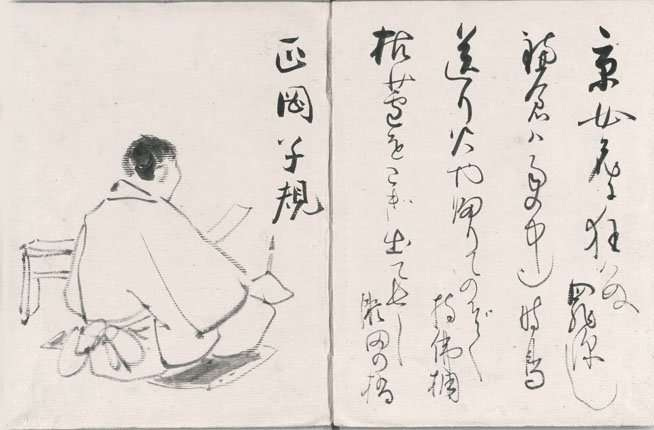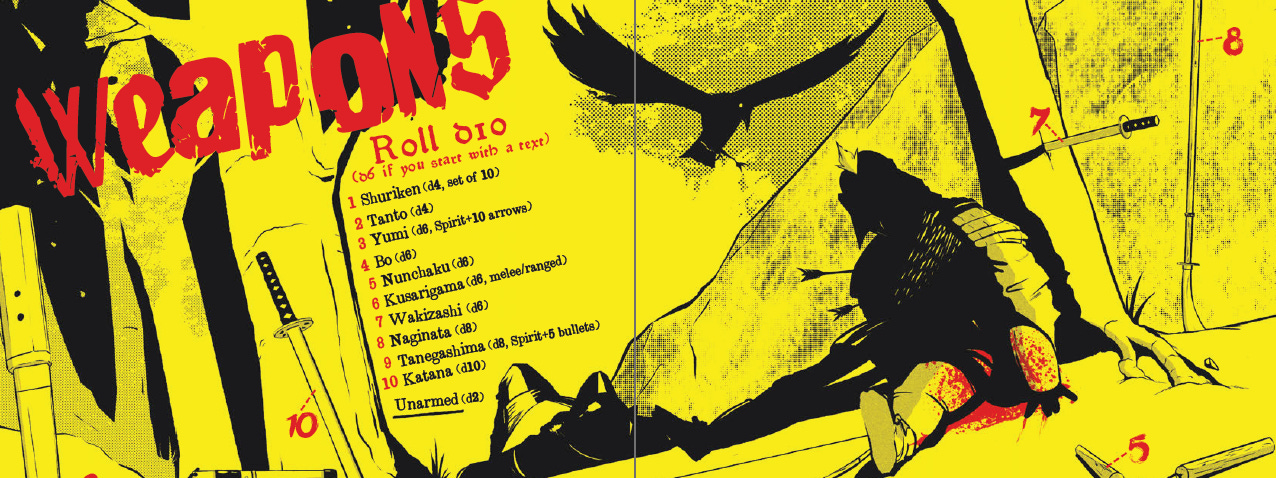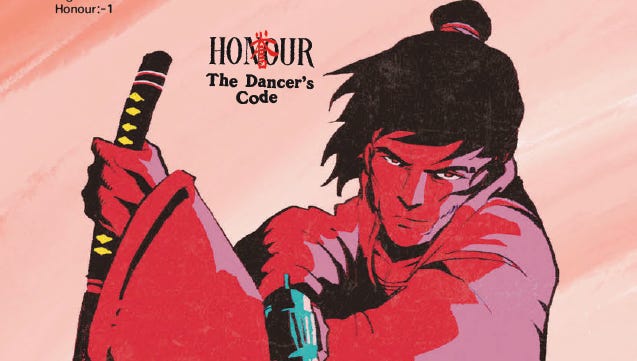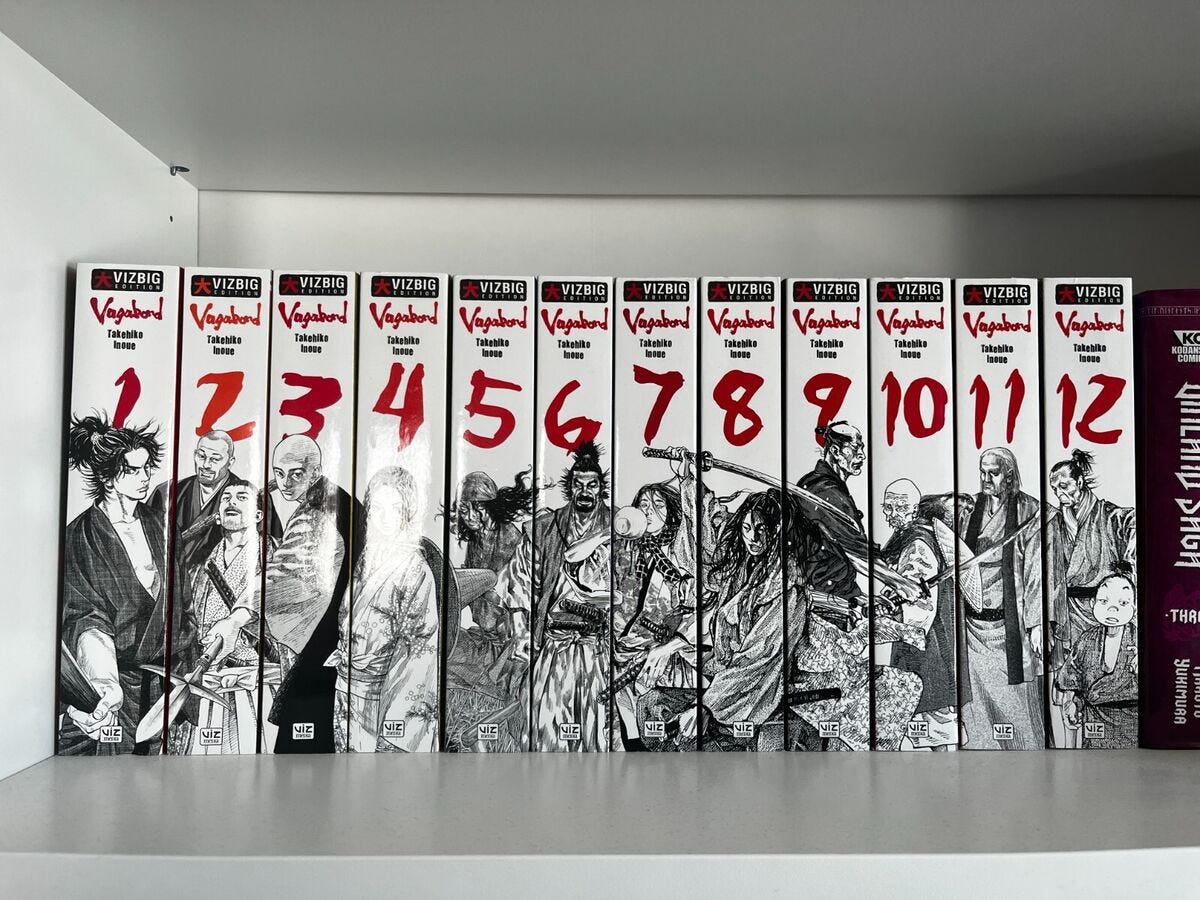Honor, Death, and Second Chances: The Innovative Mechanics Behind This Samurai RPG
RŌNIN Creator Sacha Lightfoot how traditional Japanese values shaped a Mork Borg feudal fantasy samurai masterpiece
Ronin links:
Buy RŌNIN from the official website
Follow Rōnin: Densetsu on Kickstarter
Hi Sacha, can you introduce yourself and tell us about your connection to tabletop RPGs?
Hello there, my name's Sacha and I'm the lead writer, designer, founder and dish-washer extraordinaire from Slightly Reckless Games. I started playing TTRPGs well over a decade ago now (fucking hell I'm old) and after the initial "wtf even is this?!" stage I fell in love. I still remember that very first DnD session and what happened, and I've got many more vivid memories etched into my brainbox from experiences shared at a table with my mates/comrades.
I'm a bit skittish with stuff though. We played DnD for a good few years, but it was only when I started looking at other systems and games that I saw how deep the rabbit hole went. I went digging and after dirtying my little rabbit tail I stumbled upon Mörk Borg, and after that... everything changed. (Oooo I hope that doesn't come across too cunty. Can I swear? I'm gonna swear.)
Okay, tell us about Rōnin.
Rōnin began its initial foetal development phase not long after I came across Mörk Borg and subsequently bought every zine, pamphlet and bit of wood related to it. I didn't know TTRPGs could look like this. Now, I generally have a lot of ideas—walking around, waking up in the middle of the night, etc... and I'm not bragging there because they're all mostly shite, but after days of pondering I couldn't get the idea for a samurai-inspired Mörk Borg out of my brain. So, I started writing. What might this look like? How does one balance the impending end of the world with the Japanese resolve and attitude towards disaster? Seppuku?
And so it went. Shit, I haven't actually told you about the game. Rōnin has taken on a life of its own now. It's Mörk Borg, disembowelled and resurrected on a fictional island called Kage no Shima. It's Sekiro and Kurosawa meshed and shat out by a British weeb. It's Mörk Borg with a dash of hope. It's boss and everyone should try it. We have solo rules so you can feel like an actual solo Rōnin. (That little ō is the bane of my life.)
The inspirations at the beginning of the book is an exciting list of film and anime. Which of those pieces of media do you think are absolute must-watch for GMs or players trying to get into the right mindset for Rōnin?
Anyone who hasn't watched any Kurosawa should stop reading this and go watch Yojimbo... oh wait, Ran. No, Throne of Blood. Pick one at random, you won't regret it. My background is in videography so it's hard not to let influences seep into our work. There are loads of Easter eggs in the books for samurai nerds. Blue Eye Samurai came out last year towards the end of production and rocked my world. Shōgun was sick as well.
Video games: I've already mentioned Sekiro (favourite game of all time, I think. I sweat more during that game than any other time in my life, 10/10). Ghost of Tsushima is fantastic, and Ghost of Yotei is due this year. I'm actually going to climb Mount Yotei, where the game is based, in Hokkaido during summer. I dare anyone to question my commitment to the samurai "bit".
The aesthetic of the game follows Mörk Borg's distinctive visual style but with a fantasy Nipponese theme. How did you balance creating something that honours both Johan Nohr’s visual language while establishing Rōnin's own identity?
Great use of "Nipponese" (I'm stealing that). It was a tough balancing act to be honest, especially given that it was our first project. We wanted to be faithful but put our own stamp on it. I think you can see throughout the book there's some pages that are dead-on Mörk Borg and some that are quite far away from that style. I think by the end of the project we'd found our voice, so to speak, and we went back and refined it. But it wasn't until around a year ago (just before Berserkr) that we stopped even looking at or even referencing Mörk Borg anymore—which isn't a slight, we've just developed our own style. A Rōnin style. And let me tell you, seeing people emulate that for their own 3rd Party Creations is fucking mad.
Rōnin Setting
The setting is described as an "endless eclipse"—what specific historical or mythological references influenced this particular apocalyptic scenario?
Well, Japan as a culture is fucking obsessive. They are obsessed with the MOON. They have loads of different words for it and moonlight and that kinda stuff. They also, historically, have had to suffer some of the worst natural disasters the planet can throw at them. So, they know a bit about impending doom/ever-present threats.
Eclipses were generally seen as bad omens, especially for rulers and samurai clans. You don’t want the sun going dark on the day you’re planning a coup... Eclipses were also often seen as times when the boundary between worlds thinned, which made kami (spirits) more active or agitated. Hence, all our nasty yōkai running around, terrorising the gaff. I also found records in the Nihon Shoki (720 CE) and similar chronicles that note eclipses were often followed by famine, war, or natural disasters—which inspired our Black Calendar.
The Yōkai and creatures draw from Japanese folklore. Were there any monsters that didn't make the cut that you wish you could have included?
Fucking loads. Luckily, we've got a new book coming out called The Book of Yō. There were so many weird and wonderful yōkai I wanted to include in Rōnin but they just didn't make sense for a core rulebook. But now I'm going until the wheels fall off.
Off the top of my head, I can think of:
(豆腐小僧) Tōfu Kozō, a boy who carries tofu
(砂かけ婆) Sunakake Baba, which means sand-throwing old lady
(百々目鬼) Dodomeki, which means thousand-eye demon, absolutely terrifying
(瀬戸大将) Seto Taishō, General of the Ceramics...
Having a book dedicated to these and 100ish others has been a joy to work on, honestly.
Most of the game's equipment and weapons are historically inspired. Were there any legendary weapons or items you considered including but ultimately left out?
Again, you're setting me up for our expansion. If that's on purpose, thank you. It was my intention with Rōnin to create a framework that had enough to run games on; core setting, tone, a bunch of weapons, etc. With Densetsu (our other expansion book), I've been able to go back and sift through historical documents, tales and legends, and build legendary weapons, armour and equipment that is literally rooted in Japanese myth. Shit, I’ve actually seen some of the supposed items when I was in Japan.
The Factions section introduces several competing groups. Do you have plans to expand on factional relationships and politics in future supplements?
Yes. 100% yes. In Densetsu we're going to expand Kage no Shima massively. We're creating prefecture maps within the island that feature new locations and factions. We're going to include a mini-history of the island and how these factions all interacted and obviously, fell out. Who were the big players? Who could you trust if you were a Rōnin without a lord, and who might you target as a shinobi?
While these events are mostly outlined before the eclipse's arrival, it will also outline how the eclipse has helped or hindered the various factions and clans of Kage no Shima.
The Gamblers' Pit and other locations create evocative setting elements. Were these inspired by particular historical places or fictional settings?
The Gamblers' Pit was specifically inspired by modern-day Kabukichō in Tokyo. That being said, in my prep for writing Rōnin I played Like a Dragon: Ishin by RGG; it follows Sakamoto Ryōma and the events leading up to the Meiji Restoration and, like any good Yakuza game, it has an Edo-period red-light and entertainment district.
I think it was Yoshiwara in Edo at the time (don't quote me on that one), but it was a licensed pleasure quarter full of geisha, brothels, gambling dens, and shady backroom deals. I've just had an idea actually... we need some Gamblers' Pit games to play! I'll credit you for that one, Dave.
Small aside: when I was writing Rōnin, I took all my savings that were intended for a trip to Japan and used them to pay artists and stuff. Luckily, I got to go to Japan late last year, and the sensory assault that is visiting Japan for the first time cannot be understated. It has left a lasting impression that could not be ignored when creating these new places and spaces in Densetsu. The sights, sounds and smells (or lack thereof) are forever etched in my mind, and I can't wait to go back in a month.
Rōnin Mechanics
The Honour system serves as a central mechanic in Rōnin. What inspired you to make this the core value system rather than a traditional alignment or morality system found in many other RPGs?
My experience with traditional alignment systems was that either it never really factored into decisions that were made at the table or were a little too cumbersome and invasive. This is only my personal experience and I’m sure there's plenty of systems out there that handle that stuff gracefully.
For Rōnin I wanted to say, "Hey, here's how someone of your class would have been expected to handle themselves and here's the consequences of breaking these codes — go mad." And it's created some really great scenarios; I remember last year I gave a samurai the orders from their lord that they must go into the village and collect the taxes from the local residents. The eclipse had massacred crops and left many in the village impoverished and so the samurai refused, ultimately challenging their lord to a duel. They won the duel. It was awesome. They lost a shit tonne of honour for disobeying the tenets of Bushidō though haha. The stakes were raised much higher than in the same scenario without the honour system and it's situations like that, where looting a body isn't just a given anymore.
How do you see the dynamic between the more traditional bushidō honour codes and the "dishonourable" character options like the Corrupted Shinobi playing out at the table?
The shinobi honour tenets are kind of an outlier — they still have a strict moral code, it's just a little antithetic to the other nine currently in the book. My whole goal was for the player to also have the option to be a bit sneaky with their intentions. So, if we come back to the looting-the-body example, it's expected that the samurai admit their fault in trying to loot, but the shinobi player has the option to say, "Oh, I was just checking to see if they were still alive" and kinda sneak things past the GM.
I've tried to introduce a lot of that kind of meta thing in our games. I really love Kojima and his approach to video games. Anyone who played early Metal Gear Solid games as a kid will tell you with glee about the weird meta shit he did, like switching the pads to fight Psycho Mantis or spinning Snake in MGS3 to make him throw up in the prison. I just hope we can give people similar feelings when talking about their experiences with our games.
With almost a dozen different sets of personal values called Tenets (as well as custom Tenets for any player who is inclined to come up with them), which dictate if a character gains or loses Honour points, did you envision players or the GM keeping track of all the different honour codes during a session?
I wrote in the core rulebook that it's on players to be honest with the GM about their actions. The GM can outline the consequences in terms of honour loss if required, but I wanted that theme of honour to run through both the character actions and the player actions as well. If I’m playing a samurai that wants to uphold their honour tenets of Bushidō I kinda want to embody that as a player as well — at least that’s always been my approach to getting in character when playing a game.
That’s not to say you can't play a character that goes against their tenets. Some of my favourite PCs have been cutthroat, lawless samurai that disobey their lord. So yeah, it's mainly up to the player to follow, but the GM will certainly notice egregious steps out of line.
You've created ten distinct character archetypes with unique abilities, ranging from several variants of swordfighter to drunken monk to sumo wrestler. Was there a particular archetype that was especially challenging to design or balance within the game's thematic framework?
Yeah, my approach was — and it was the same with Berserkr — that there's always going to be fan favourites, especially with something so entrenched in genre tropes, and they are going to be a lot of players’ go-to's. I don't think I've run a game where at least one person didn't play a rōnin. I get it — it's the name of the book.
So, I try to give as much care and attention to the characters that may be less picked or loved so that they can at least feel fucking awesome to play when partying up with those fan favourites. In terms of challenging archetypes, the Erudite Samurai was certainly up there. I think when most people picture a samurai it isn’t with his head in a book, but the fact of the matter was that the word samurai means "to serve" or close as dammed. And a samurai wasn't just in service of his lord as a means of violence — they were expected to be cultured, learned and pursue arts. So, balancing that aspect with chopping down yōkai was a fun but challenging hill to climb.
The Yomi underworld and (potential) resurrection mechanic creates an interesting "second chance" system when characters die. What inspired you to develop this instead of more permanent death consequences or simpler resurrection mechanics?
So, my first ever game of Mörk Borg that I ran was Rotblack Sludge for a couple of buddies way back when. There were two players and five PC deaths that night. It was hilarious, but I knew with Rōnin that I wanted to alleviate some of that lethality a bit.
As a player, one of my favourite things to do in a TTRPG is explore my character and their motivations and how they develop — and that's difficult if I die after an hour. So I thought, what about two hours?
I've mentioned Sekiro a few times and I always loved that it gave you a second chance. There's nothing better than being beat by a boss, getting up, locking in and then winning. So I tried to recreate that a bit — only with our game, you would have to beat a boss to come back. I wanted it to feel like you really earned a second chance, you know, and that your character would feel a renewed sense of hope in a world that's all but given up. Kinda echoing what I said earlier about the Japanese temperament.
It also means that a boss battle can happen literally at any mild bit of danger in the game. You fall off a building while sneaking into a palace? Well, guess you're off to Yomi for a boss battle. Your mate gets stabbed trying to help you? Looks like you just got an ally to help you come back. This back-and-forth experience really gives combat an added layer.
The Kuroi Koyomi (Black Calendar) countdown system continues Mörk Borg's apocalyptic tradition. How did you adapt this to fit the Japanese-inspired setting while maintaining its dread-inducing purpose?
So I had lengthy discussions with our sensitivity reader Sachiko around the Black Calendar and my initial iteration was actually a lot more Christian-inspired, like the Mörk Borg one. But she advised that Japanese people didn't really think in that kind of way and that it might be more appropriate to incorporate elements like water and light as the main themes around the bad things that would befall the island of Kage no Shima.
Obviously, mechanically it's very similar in that the dice decide the frequency of woes and after the last one the world ends — it’s just more in line with Japanese philosophy.
The duelling system adds strategic depth beyond standard combat, yet is extremely fast and deadly. What was your design philosophy behind creating this alternate combat option?
Vagabond. This manga is the greatest manga of all time and I'm getting both Miyamoto Musashi and Sasaki Kojirō tattooed on my chest in a few weeks. The manga chronicles Miyamoto Musashi's journey from young bloodthirsty beast to a man who contemplates all the things covered in his Book of Five Rings.
The way it explores duelling is all about the build-up and the aftermath. An actual duel would last mere seconds in old-timey Japanese land, despite what anime and films may have you believe, so I really wanted to capture the lethality and speed of it — and that even an inexperienced opponent can get lucky and kill you.
And if you want to be a beast at duelling, pick the Sword Saint or our Musashi-inspired class from the upcoming expansion Densetsu.
The "Haiku" mechanic for meditation is a uniquely thematic touch. What gameplay experiences were you hoping players would have with this feature?
I've always found that when playing TTRPGs, people generally don't take moments to just sit and experience the moment — both as a player and character. We're all sitting down for drama and excitement and cool shit, but I thought it would be nice to give a mechanical bonus to a PC that wants to take a moment and just think about where their character is and how their current situation is affecting them.
Also, watching my group try to come up with the real-life haiku was a wonderful experience. I think Waka poetry was actually the more popular type around that time, but I read during development of Ghost of Tsushima that they too decided to call it Haiku just to be a bit more accommodating to the Western palette. When we release the game in Japanese, it'll be called Waka though, no doubt. Blitzball reference, anyone?

The "Kami's Vengeance" table creates dramatic consequences for magic failures. Did you have particular favourite outcomes from playtesting?
Honestly, my first version of that table was quite tame. It was actually my best friend and business partner, Dom, who said to me, "These are only on fumbles, they should be mental" — and thus the table got weirder and weirder as development went on.
The “A continuous drizzle follows you, even indoors. Surfaces you walk on become slippery, requiring you to Test Swiftness DR12 to avoid falling.” is a personal favourite because it's just so cartoonish and out of place haha. Like, imagine going to demand a Daimyō tells you the location of a farmer’s daughter — all the while, there's a small cloud raining on you. Maybe that's just growing up in the UK for you though.
The Densetsu Expansion
What can you tell us about the upcoming Densetsu Kickstarter?
Well, I've already spoken about it quite a lot in this interview, but the Densetsu expansion will be a collection of short tales, poems and stories inspired by actual Japanese folklore. These writing elements will have multiple game elements weaved into them — ranging from full mini-adventures like our recent Trials of the Tengu to new classes, weapons, armour etc.
We're also using Densetsu to flesh out Kage no Shima in terms of its history, the cultural events and factions, and really give the island a big breath of life. We've also made the commitment to have at least 50% (though at this point it's looking like 75%) Japanese native artists on Densetsu.
Then The Book of Yō is all about yōkai, Yomi and the shit that creeps around in Kage no Shima. In the land of endless night, there's no shortage of horrors, and this book lifts the lid on those. 100+ yōkai, forbidden texts, rituals, cursed items etc. We're really trying to lean into the light and dark themes of both books.
Plus, we've got loads of other cool shit planned, especially with stretch goals and the like. Please come and check it out — we're running a 50% sale on the digital versions of all our stuff at the minute on our website, that'll run until the Kickstarter on April 15th. And if that's still too much, just go torrent it. It's out there for sure.
What new cultural elements or character types are you exploring?
All of it. No joke, I've not stopped reading Japanese books and tales and history for like four months now. There's absolutely no shortage of inspiration. While Rōnin was a love letter to Japan and its mythology and history, Densetsu is almost like Japanese history porn at this point. Every tale, every item, every piece of it has been meticulously researched — and the same goes for the yōkai in The Book of Yō. I'm trying really hard to make sure the blood that runs through these pages is both respectful and celebratory of Japanese culture, its people, and the country itself.
Starter sets, so hot right now. What will the Rōnin starter set include?
I'm not afraid to jump on a bandwagon. We're dealing with Mörk Borg after all. It will have everything you expect from a starter set:
A condensed Player’s Guidebook
Shunkashūtō — an exclusive four-part adventure set across Japan's distinctive four seasons
Battle maps
Prefecture map
A special Yomi map for resurrection combat
Custom punch-out tokens and reference cards
Character sheets
Pregens
An exclusive dice set
Everything a budding wanderer needs. I'm actually just about to start writing the adventure and I hope people like it — expect a twist or two!
Where can people find you online, Rōnin, and its expansion project Densetsu?
If you want to find me just shout "Sacha" from your window and I'll appear.
Online at slightlyrecklessgames.com
We're on some of the social medias, but we barely post because I'm bad at that kind of thing. Follow us anyway though — someone will step up eventually haha.

















really looking forward to tracking this one. Great read.